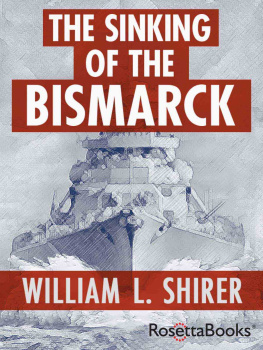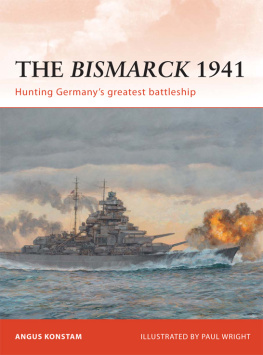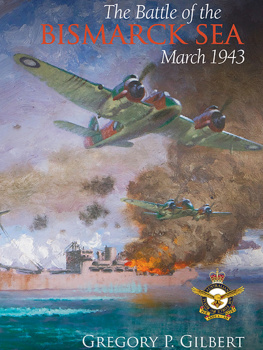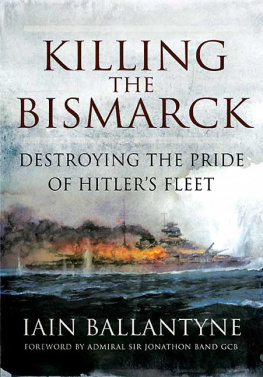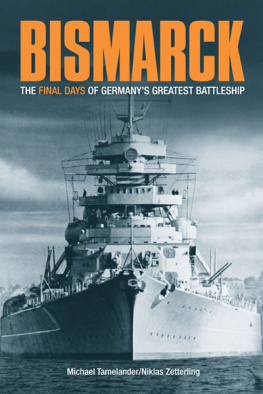The Sinking of the Bismarck
William L. Shirer
Copyright
The Sinking of the Bismarck
Copyright 1962, 2014 by William L. Shirer
Published 2014 by RosettaBooks
All rights reserved. No part of this book may be used or reproduced in any form or by any electronic or mechanical means, including information storage and retrieval systems, without permission in writing from the publisher, except by a reviewer who may quote brief passages in a review.
Cover design by Alexia Garaventa
ISBN e-Pub edition: 9780795342462
Maps
Chapter One
The Mighty Bismarck Goes to Sea
It was a dark and perilous time for Great Britain.
The second spring of World War II had come, and the British stood alone against the seemingly invincible might of the German armed forces.
Germany, which had provoked the war on September 1, 1939, by attacking Poland, had conquered most of Europe. In 1940, led by the ruthless Nazi dictator, Adolf Hitler, the Germans had overrun Norway and Denmark, Holland, Belgium and France. And they had chased the remains of the British Expeditionary Force across the English Channel. After the fall of France, in late June, 1940, Italy had come into the war on the side of Germany. Under another fascist dictator, Benito Mussolini, Italy was threatening the British position in the Mediterranean Sea and in Egypt.
At the beginning of April, 1941, the victorious German army had advanced into Yugoslavia and Greece in the Balkans and quickly occupied them. The British, who had come to the aid of the gallant but small Greek forces, were pushed out of the mainland of Greece. They were trying to make a stand on the Greek island of Crete.
At home, England was taking a severe battering from German bombers. All that winter of 194041 the Nazi planes had come over night and day, dropping their lethal loads. Large areas of London and other cities lay in ruins.
At sea, the British, whose navy had ruled the waves for centuries, were in a desperate situation. And it was getting worse.
Since their summer conquests of 1940, the Germans had been able to utilize the harbors and airfields along the coast of western Europe. These stretched from northern Norway to southern France. From their new bases German submarines, warships and bombers had ranged out to sea and taken a fearful toll of British shipping, on which the very existence of Britain depended. By the spring of 1941 British shipping losses had become so great that there was a grave question whether the island nation could hold out.
In February and March of that year, the powerful new German battle cruisers, Scharnhorst and Gneisenau, broke out into the Atlantic and sank twenty-two British merchant ships. They then managed to get back to the French port of Brest.
Early in May the British Admiralty learned that the new German battleship Bismarck, the most powerful warship afloat in the world, had completed her trials in the Baltic. Any day now she might put out to sea to prey on British shipping.
Many of Britains battleships and aircraft carriers were not available for use against the Bismarck in the Atlantic. They were on duty in the Mediterranean trying to check Italy, which had a large navy of her own. They were also busy helping the British armies fighting the Germans in Greece and the Italians in North Africa.
On the morning of May 20, 1941, the Germans launched the greatest air-borne attack in the annals of warfare on the British positions in Crete. A large part of the British Mediterranean fleet rushed to the scene to help the army, which faced another defeat. There was gloom in London as news of the German air-borne onslaught came in. But deeper gloom was to come from other news the next day.
***
At 8:00 A.M. on May 21, a coded message arrived at the Admiralty in London from a British agent in Sweden. On the previous afternoon he had seen from the Swedish shore two large German warships steaming north through the strait between Sweden and Denmark. The ships were obviously en route to German-held Norway, from whose many harbors and fiords German warships in recent months had broken out into the Atlantic.
The ominous report was flashed at once to Sir John Tovey, commander in chief of the Home Fleet. He was on his flagship, King George V, at Scapa Flow, the great naval base in the Orkney Islands at the northern tip of the British Isles. Sir John was a wiry little man of quiet temperament, who remained calm in emergencies. He had a reputation in the navy for spreading confidence, and even optimism, among his officers and men.
The news he received on the morning of May 21 did not surprise or shake him. But he realized its importance. He immediately summoned his staff officers to discuss it. Their task was to ascertain which German warships were putting to sea, what they were up to, and where. Then they could take appropriate counteraction.
Admiral Tovey was quite sure that the reported German warships were the battleship Bismarck and a heavy cruiser of the Hipper class. From naval intelligence he knew their fighting qualities.
I myself had seen the Bismarck and the cruiser Admiral Hipper in the naval yard at Hamburg on Christmas Day the year before. There I had had an opportunity to learn something about these ships. In their respective classes, they were more powerful than any British or American ships then afloat. I knew that the German government had lied in officially listing their size.
At this time the British and American navies were still abiding by a disarmament treaty which limited battleships to 35,000 tons and heavy cruisers to 10,000 tons, but the Germans, while listing their warships at approximately those figures, were actually building them bigger. The Bismarck displaced 42,800 tons; the Hipper-class cruisers, 14,000 tons. (The German battle cruisers Scharnhorst and Gneisenau, though registered as 26,000-ton ships, were in reality 31,300-ton vessels.)
The Bismarck was easily the most powerful battleship afloat. It had eight 15-inch guns in four turrets, two fore and two aft. It had eighty-one smaller guns, mostly anti-aircraft. It had a speed of twenty-eight knots which could be increased to thirty-one knots at extreme pressure. The most heavily armored ship yet built, it had the additional protection of a special anti-torpedo belt of nickel-chrome-steel. No torpedo then in use by the Britishor so the Germans believedcould penetrate this belt. The Germans were convinced that the Bismarck was practically unsinkable. And so it turned out to be, as we shall see.
What the German battleship was up to, Admiral Tovey could easily guess. It would be gunning for British shipping in the Atlantic. At that moment ten precious convoys were at sea. An eleventh convoy was scheduled to sail the next day for the Middle East. This was the most precious of all. It had 20,000 British troops aboard. Not one of these convoys had sufficient naval protection to stand up to the mighty Bismarck.
What did the British navy have in fighting ships to match the Bismarck? And, more important to Sir John, what did they have to catch and sink her?
No single capital ship in the British fleet could match the Bismarck with the possible exception of the 42,000-ton battle cruiser Hood, the largest vessel in the British navy and its great pride. But the Hood, like all battle cruisers, had sacrificed armor protection for speed.
Admiral Tovey knew that he was superior in numbers. He had in his Home Fleet at Scapa Flow two new 35,000-ton battleships,

